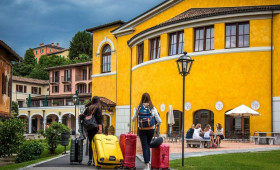Advanced Placement (AP)
03.10.174533
The benefits of AP program for students preparing to enter Universities in the USA and Canada
The secondary education system in the United States of America fundamentally differs from the education system most of us are used to. The first thing you will notice about this system is that it clearly has other priorities in mind - teaching in the U.S. focuses on the individual qualities of the pupil, striving to develop his distinctive talents and personality.
This system is designed to prepare students to select their future career while still at school and help them take their first steps in obtaining the placement in the undergraduate programme of their choice. That significant advantage is characteristic of the secondary education system in the United States and Canada.
The most effective way to receive a spot in the American or Canadian university is to enrol in the Advanced Placement (AP) programme. This programme was designed primarily to prepare high school students for study in colleges and universities in the U.S. and Canada.
Peculiarities of American education
It is worth to keep in mind that education peculiarities in the USA vary from state to state. Overall the system can be divided into two levels of education:
- primary education from grade 1 (from 6 years old) to grade 5 (11 years old);
- middle school from grade 6 (12 years old) to grade 12 (18 years old).
Secondary education is further divided into Middle School/Junior High School (up to 8th-9th grade, depending on the institution and the laws of the state) and High School/Senior High School.
Middle schools in North America allow pupils to study extracurricular subjects in addition to the general curriculum, which can be taken at their discretion. At High School phase, the number of available additional subjects increases further.
Starting from the 9th grade, students gain both knowledge and credit points for all the subjects they follow and complete. To receive American High School Diploma students need to earn between 20 and 24 credits (depending on the state) in the duration of the studies, with each subject generating one credit.
In the last two years of High School, students are offered an option of an in-depth study of certain subjects. This in-depth study is called the Advanced Placement program. Completing the AP programme allows students to apply to 90% of American, Canadian and British universities, as well as to colleges and universities in more than 50 other countries.
Requirements for enrollment into undergraduate programmes varies per university. And while most colleges will accept students who showed average results in the AP programme, universities like Princeton, Harvard or Yale will only admit students with excellent results.
WHICH SUBJECTS ARE TAUGHT AT ADVANCED PLACEMENT
Advanced Placement consists of 37 subjects (since 2008). Many of these disciplines are taught in the first year of undergraduate studies. Completing these subjects during AP has the benefit of being considered during the admission process and transferred as study credit at the university.
Among the courses taught at the AP programme are:
- english language and literature;
- foreign languages (including French, German, Italian, Spanish, Japanese, Chinese);
- history (political history, European history, global history, the history of the USA, and art history);
- science (chemistry, biology, multiple levels of physics);
- geography;
- economy;
- statistics;
- mathematics;
- computer science;
- psychology;
- art (design, drawing).
You will also encounter some highly specialized disciplines among these courses, such as the study of Latin through the works of Virgil. Prestigious private schools in America strive to increase the number of AP courses to attract high-achieving, gifted students.
Each course usually lasts for an academic year (even though there can sometimes be as many as 8 classes a week per subject). At the end of the year, students take a written test to receive an attestation.
How to read AP test results:
The AP programme uses a five-point system:
5 – Extremely well qualified;
4 – Well qualified;
3 – Qualified;
2 – Possibly qualified;
1 – No recommendation.
The total score is the sum of all points earned by the student. Much more complex system is in place for marking essays, which is done by independent professional editors - so-called readers. To avoid confusion, what you need to know is that the final mark is given by the panel of experts and not by a single teacher.
The benefits of completing the AP programme
- Priority for admission to the universities or colleges in the USA, UK or Canada and other countries (as long as your overall grade is no lower than 3).
- Credits, which sometimes allow students to skip a whole semester of university studies.
- The abolition of entrance examinations/coursework at universities where such procedure is mandatory.
- A chance to get enrolled into the second year of university studies, replacing students who dropped out in their first year (USA and Canada).
- An in-depth study of core subjects, without having to take preparatory courses.
- An opportunity to obtain a bachelor's degree in less time.
- A great chance to receive a scholarship: according to the findings of the College Board USA, 31% of American universities will take into account the results of AP Programme when choosing students to qualify for the scholarship.
To cost of AP exams: each written test costs $91.




















